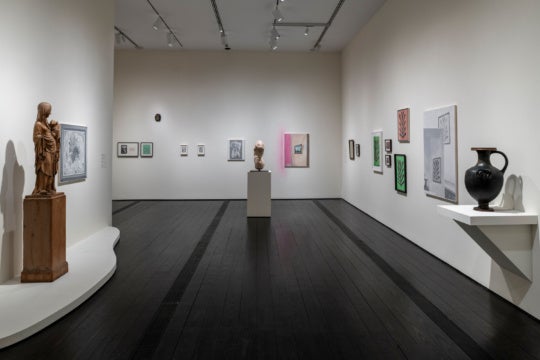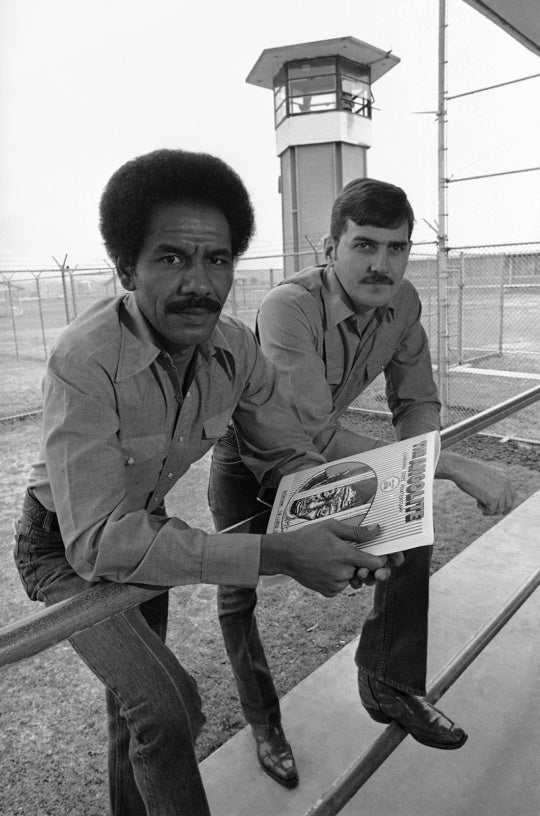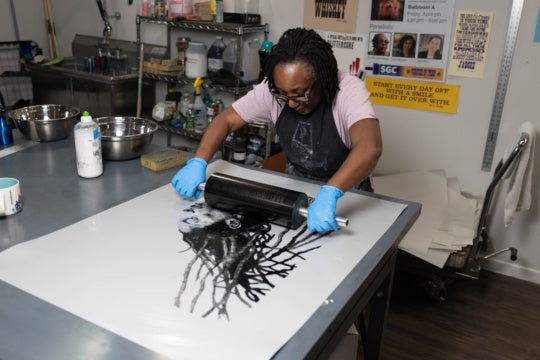
“There are things here not seen in this photograph.” The words are handwritten in all caps above a black-and-white image of a vacant city tavern—two empty bar stools; liquor bottles along the wall; cigarette dispenser; linoleum floor littered with butts, awash with sunlight from an open door.
It’s the kind of abandoned setting one’s imagination can’t help but fill with a story, which is exactly what photographer Duane Michals (b. 1932) provides in the margin below his image: “My shirt was wet with perspiration. The beer tasted good but I was still thirsty. Some drunk was talking loudly to another drunk about Nixon. On the jukebox Glen Campbell began to sing about ‘Southern Nights.’ I needed to go to the men’s room. A derelict began to walk toward me to ask for money. It was time to leave.”
The cursive is messy, as if jotted down in a rush; the sentences choppy like a Hemingway novel. Before we know it we’re leaning into the photograph, peering deeper into the static scene, searching for clues.

Can a photograph tell the whole story? The question echoes throughout “Duane Michals: The Narrative Photograph,” an exhibition that spans the photographer’s work from the 1960s through 2015, on view at Jackson Fine Art in Atlanta.
You can almost feel Michals’s presence as you peruse his pieces, or imagine him popping in (with a mischievous grin, perhaps) to interject a witty comment about each. Many of his works are series of images that together tell a story. Still more incorporate either handwritten notes or vibrant paint strokes. Near the gallery entrance is Summer (1984), a black-and-white portrait of a girl that’s colorfully painted with butterflies, some of which alight on her face and cling to strands of her fine, blonde hair. Her expression gives no clue that she’s aware of their presence.

Michals often plays with perception—challenging photography’s perceived objectivity by making it convey things reality cannot. For instance, in the series The Spirit Leaves the Body (1968), a translucent figure rises from the body of a prostrate man and walks toward the camera, frame by frame, like a ghost. In The Illuminated Man (1968), an ordinary guy wearing a button-down shirt in a subway tunnel has a faceless, glowing white head.

But perhaps the most telling of his works is Duane Photographs Anthony Red (2015), a joking yet thought-provoking series that reveals not only photography’s ability to change the viewer’s perception of a subject but how the subject may be affected by that imposed perception. In the first photo in the series, Michals and the artist Anthony Goicolea have a stare-off through the camera lens. In the next photo, Michals seemingly begins painting his camera red with a brush (the red color is painted directly onto the black-and-white photo). Frame by frame, as he paints his camera red, his subject’s face becomes red as well. By the last photo, Anthony’s face is an opaque red mask, stiff and expressionless. He looks dejected and uncomfortable.
Like most of Michals’s works, Duane Photographs Anthony Red has a jocular, light tone—playfulness bounces between the two subjects. But there are also important questions at play: Does a photographer impose perceptions? Are those perceptions detrimental to the subject? What else is not seen in a photograph?
“Duane Michals: The Narrative Photograph” is on view at Jackson Fine Art in Atlanta through December 3.
Amanda Arnold is an Atlanta-based writer and editor whose pieces on travel, lifestyle, food, photography and other topics have appeared in a variety of print and online publications, including Professional Photographer, Rodale’s Organic Life, Forbes.com, Forbes Travel Guide, and HowStuffWorks.




